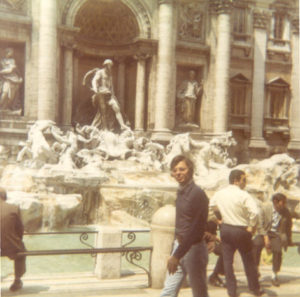
Rome’s Trevi Fountain, 1970
When we last left Sandy Coghlan, an Aussie baby boomer who has written up her 1969-70 European travels in her new book, Yesterday: A Baby Boomer’s Rite of Passage, she was in Monaco enjoying the somewhat casual changing of the guard in front of Prince Rainier’s and Princess Grace’s fairytale palace.
If you haven’t read Part I of excerpts from her travel diary, you can go there now. As with Part I, I’ve added some of my own notes to provide context. Sandy has included her vintage photos and a few postcards from her travels.
We pick up the narrative in Rome, where she has gone to work as an au pair, looking after five children under the age of seven. (She confesses she got the job by saying she was the oldest of five children and had lots of experience looking after her younger siblings. Actually, she is an only child.) Her hours were 7am to 10pm six days a week, but she still managed to work in some sightseeing:
By Sandy Coghlan
ROME (March 1970)
I spent today at the Colosseum. Imagine it, there I am walking along a street towards the general area, then I suddenly catch a glimpse of it in the distance! It made me gasp out loud! The closer I got, the more excited I got.
The road you have to cross to it is very wide and the traffic is just crazy. No-one seems to follow road rules here. You can stand on the footpath all day waiting for a break in the traffic, but the
Italians just walk across, almost without looking, and the cars (mostly little Fiats) zip around them, but just standing across the road and looking at it is an experience in itself.
The Colosseum was built nearly 2,000 years ago and has had some damage from earthquakes, so a few bits have fallen off here and there, but considering its age it’s holding up pretty well.
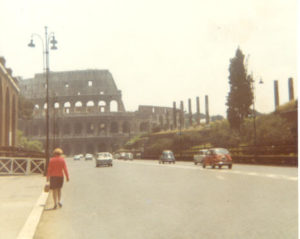
Roman Colosseum, 1970
I have to keep reminding myself that I’m not watching a documentary or seeing a photo in a magazine. I’m really in Rome!
I eventually braved the crossing, and wonder of wonders, I survived. There were cute little horse-drawn carts outside waiting to take tourists on trips around the city, but I just wanted to get inside.
Once I entered, I was in this huge amphitheatre and I just stood in the centre and tried to imagine what it must have been like when up to 80,000 spectators came to watch gladiator contests, and of course, Christians being eaten by lions.
It was a real goose-bump moment, but I found it slightly amusing that it’s now populated with hundreds of stray cats! I wondered if they were distant descendants of the original hungry lions.
Clark’s Note: Sandy burned out from the long au pair hours after a month, resigned her job, and retreated to a youth hostel, where she met a California girl (Jeanne) who wanted to see Greece. Sandy was game for that, so off they went. Or so they thought:
HITCH-HIKERS (April 1970)
Next morning we were standing on the side of the road wiggling our thumbs again when a car stopped and the driver shouted out “Good morning, Australia!” He was from Brisbane and he took us to the autostrada (freeway). It was wonderful to hear the Aussie accent again.
It didn’t take long to get a lift from there; we got picked up by two crazy Italians. And I do mean crazy. Neither of them spoke a word of English but they were talking, singing and laughing non-stop and they had us in fits of laughter all the way!
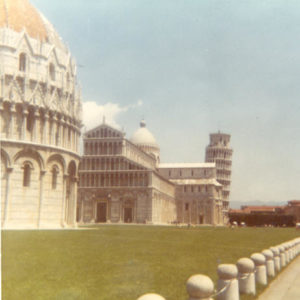
Pisa’s Leaning Tower, with no tourists, in 1970.
I managed to interpret some of what they said. They worked in the toll booth at the Autostrada further up the line and were on their way to work. We had no idea which direction we were going, but we figured an autostrada is an autostrada and we were having too much fun to ask questions.
On the way to wherever we were going, they stopped in a small town and pulled up next to a park. We had no idea where we were, or why, but suddenly Jeanne gasped and nudged me and
pointed to …. a very crooked tower. Yes, we were in Pisa! YAY!
It looked just like it does in photos! It’s in a big open grassy area and it really does lean! A lot!
There was no-one else around so we had it all to ourselves. They took us inside and it was so strange walking up the spiral stairs: sometimes you’re going steeply up hill and other times you’re almost going level. I felt like I was drunk, or back on the ship in a rough sea.
Then they took us to lunch in a little cafe in Pisa and we had the most fantastic ravioli I’ve ever tasted in my life, and red wine! Delicious. And they paid for everything!
After lunch they drove to the autostrada entrance and showed us where to stand, and we were picked up quickly. They gave us a wave and a wink and a big laugh as the car drove past their booth.
Clark’s Note: So much for Greece — Pisa, in northwest Italy, is in the opposite direction from where they needed to go (northeast). But here’s the beauty of traveling without an itinerary: you can follow the winds, as the old song goes.
And the winds were blowing toward Barcelona. Or, at least, an inexpensive ferry called the Green Kangaroo, which they boarded in Genoa, was headed there. So they hopped aboard, and when they got to Spain met some apparently manic Americans:
BARCELONA (April 1970)
We met a group of Americans at the cathedral. They arrived in Belgium just four days ago and have seen Holland, Belgium, and France. Now here they were in Barcelona.
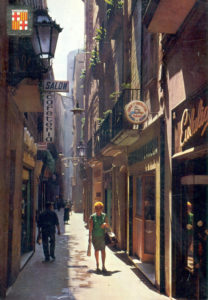
Barcelona, 1970
How is that possible? We gave them the advice we were given once and laughed at: “Don’t make plans!”
They said they only had three weeks and intended to “check out the rest of Spain,” then see Portugal, Italy, Switzerland, England and hopefully if they had any time before their flight back, Greece and especially the islands.
Good luck with that plan!
Clark’s Note: After Sandy and Jeanne left Barcelona, they hitch-hiked down the entire east coast of Spain, headed for Gibraltar, where they hoped to find work. It was inevitable in those days to be picked up by:
THE FLOWER POWER COMBI VAN (May 1970)
We got a lift with four hippies in a VW combi-van today. Two were sitting in the front seat, the other two sprawled in the back, so we sat leaning up against the side behind the passenger seat.
Jeanne played her guitar and we were all having a nice time, singing along. I turned to look out the window behind me and all I could see was ocean way down below! We were travelling along a road on a very high cliff, and were right on the very edge. The driver didn’t seem to be paying much attention — he was more involved in our sing-along.
Actually, I suspect they’d all had a funny cigarette not long before we joined them, because they were giggling at everything. I nudged Jeanne. She turned to look and we both leapt forward in a panic.
I think the two fellows on the other side of the van thought we were about to attack them, but we sure as hell didn’t want to add any weight to the drop-away side.
We both yelled “Get over” to the driver and he swung the steering wheel in fright, almost driving headlong into an oncoming car — which was probably preferable to swinging it in the other direction!
Clark’s note: Having survived the Flower Power van, Sandy and Jeanne found themselves walking through the Spanish countryside with few prospects for hitch-hiking:
THE BULL (May 1970)
It was between Almeria and Malaga that we saw … the bull. Yikes!
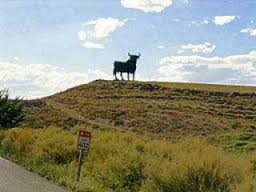
The menacing bull atop the hill, 1970
We were walking along a country road, miles from town and surrounded by nothing but flat grassy landscape as far as the eye could see, lazily wiggling our thumbs whenever a car came past, which was rarely.
Ahead of us, rising up from the road, there was a gently sloping grassy hill — and we suddenly noticed that standing on top of it, silhouetted against the sky, was a gigantic black bull.
There were no fences around the hill! Just a hill. And a bull. And us. A raging gallop or even a leisurely trot would bring it down to meet us face to face in seconds.
Do we stop? Do we try to hide behind a blade of grass? Do we keep walking and hope it doesn’t see us? Do we start running for our lives in the opposite direction? Or do we quietly turn around and tiptoe back the way we came?
I suspect we need our heads examined, because we decided to just keep right on walking! Quietly but quickly. No talking. No stopping. Just praying that it wouldn’t notice us while we silently planned our escape route if it did.
The closer we got, the bigger the bull got. It was huge! Were we crazy? We were getting very nervous but it hadn’t moved the whole time we’d been watching it so I thought maybe it was sleeping.
Do bulls sleep standing up? Who knows! At least it hadn’t lowered its head to snort a warning. That was encouraging.
Well, it turned out to be an advertisement for brandy! Just a harmless old tin cut-out propped up from behind!
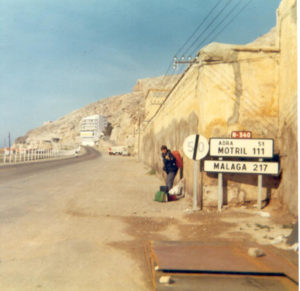
Jeanne hitching to Malaga, 1970
If we’d kept moving at the speed we approached and walked past it, we probably could have made it all the way to Malaga without needing a lift!
Clark’s Note: The route to Gibraltar was a circuitous one, since the border was closed between the “Rock,” a British colony, and Spain, which claimed Gibraltar as its own.
This necessitated a ferry ride to Tangier, in Morocco, where they caught a ferry back to Gibraltar:
GIBRALTAR (May 1970)
Last night we went to a Wimpy bar. They’re yummy hamburger cafes and they’re all over London, so it wasn’t surprising they’d have one in Gibraltar.
But it was so funny, because everyone in Gibraltar is either English or wants to be English, so the hamburgers are served on a plate and everyone eats them with a knife and fork.
Poor Jeanne had never eaten a hamburger with a knife and fork in her life, but she tried oh so valiantly. Of course, she had to make it even more complicated by doing it the American way: cutting a piece off, putting her knife down, changing hands and picking the piece up with her fork. It took her ages just to get through a third of it.
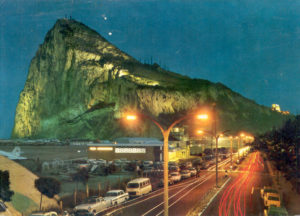
Gibraltar at night, 1970
Finally she said “Enough!” and picked it up with both hands.
Clark’s Note: Having been denied a work permit in Gibraltar, Jeanne bought an old army jeep there, which, of course, had to be ferried back to Tangier and then ferried back again to Spain.
They then drove up through central Spain to Madrid and back to Barcelona. Keeping in mind that at the time Spain was still under the thumb of the dictatorial Francisco Franco regime, this happened:
MANANA (May 1970)
We were driving along a mountain road and were just going over the top of a hill when two traffic cops on the side of the highway waved us over.
Jeanne stepped on the brake. We sailed past them. She pulled the handbrake. We still kept going.
Aware that we were about to be arrested (if they managed to catch us) and thrown into a Franco jail to rot for eternity and that no one would ever know what became of us, we finally rolled to a stop at the bottom of the hill.
The policemen climbed onto their bicycles and casually free-wheeled down the hill.
Well, all they wanted was to ask us how long we’d been in Spain and whether we liked it! They just wanted to chat, for heaven’s sakes!
After we told them where we were from and where we’d been and how much we absolutely loved Spain best of all the places in Europe and probably the entire world, we drove off.
Very, very slowly and very, very carefully, until we came to the next place, Calatuyud.
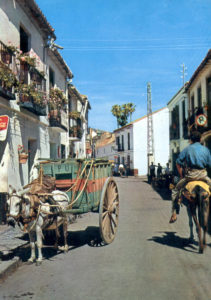
Alicante, Spain, 1970
We rolled into a service station there and managed to make them understand what was wrong with the brakes, and they phoned a mechanic. He came down and towed us back to his garage,
put the car inside, locked the door, and pointed to his mouth. Time for lunch.
We sat on the sidewalk from midday until he returned at 3:30. How could we have forgotten about the Spanish siesta?
Can you believe what he did then? He opened the jeep’s door, looked inside, walked around the outside and then said what you’re told every Spaniard says but you don’t actually expect to hear.
Just like the Italian Mamma mia, the French oo-la-la, and the cockney cor-blimey: He said “manana”. (Tomorrow)
Clark’s Note: After finally making it back to Barcelona, it was on to the mountains and a big surprise:
PYRENEES (May 1970)
This morning we said a fond farewell to Barcelona and drove through a section of the Pyrenees mountains. They stretch 450 kms from the Atlantic to the Mediterranean and divide Spain from France.
In the 12th and 13th centuries the Cathars dared to set up a religious order there that wasn’t Catholic because of the corruption of the church at the time, and they were hunted down and persecuted. Over 200 of them were burned to death when they refused to renounce their faith.
The mountains were also an escape route for people trying to get out of war-torn Europe when the Nazis occupied France and Italy, and many were ambushed and shot on the way.
Was it ever spooky! Dark, narrow roads, lots of tall trees either side, not a soul around. It was really eerie and we both felt uncomfortable. I suspect there be ghosts roaming them thar hills!
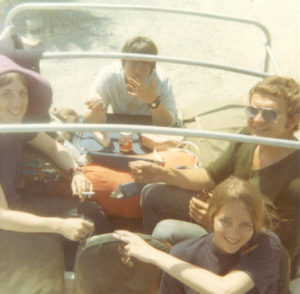
Hitch-hikers that Sandy and Jeanne picked up along the way, 1970.
Then a policeman — yes, another one! — appeared out of nowhere and pulled us over!
Naturally we thought we were in trouble again, but he just kept waving us over to the side of the road. We did as we were told and prepared ourselves for the worst.
Suddenly a group of bike riders came past. Then more. Then, even more. We were sitting there for about an hour while this big damn bike race went by!
We found out later that it was known as the Tour de France, but they were in Spain so I think they must have got lost!
Clark’s Note: When they reached France, Sandy and Jeanne drove along the Riviera toward Italy, picking up and dropping off a number of hitch-hikers along the way. They were headed back to Rome, where Sandy had left some luggage in storage, but first they had to make it to their hostel there:
RETURN TO ROMA (May 1970)
Driving through Roma at peak hour was terrifying!
Our three hitch-hiking passengers had to be our mirrors. Mike, Cathy and Marilyn were in the back seat loudly alerting Jeanne to what was coming from behind and beside us, and because I was in the front seat and knew the way to the hostel, I was yelling out where to turn and which streets to use.
We all had to yell because as usual, everyone in Rome was blaring their horns and poor Jeanne was going crazy just trying to stay on the road with cars and buses and blaring horns and yelling Italians and even louder yelling passengers.
We made it! Exhausted, but safe. We were so relieved to pull up at our old hostel that we knew so well and remembered so fondly.
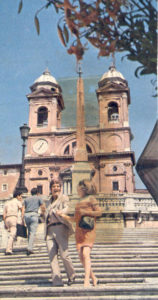
Rome’s Spanish Steps, 1970
Clark’s note: “We survived” — that says it all:
WE SURVIVED
That night, as we described our journey to fellow travellers in the hostel’s common room, we began to realise how much we’d seen and done.
We had hitched, walked, cruised, bused, ferried and driven over 3,000 miles, or nearly 5,000 kilometres.
We had thumbed our way through northern Italy, cruised the Mediterranean, hitched from north to south along the entire Spanish coastline, ferried back and forth twice between Spain, Morocco, and Gibraltar, driven through the centre of Spain from south to north and traversed part of the spooky Pyrenees and the entire French Riviera.
We’d climbed the Leaning Tower of Pisa, visited art galleries in Florence, spent a day at the Prado in Madrid, seen Barcelona’s La Sagrada Familia cathedral, holidayed in Benidorm, romped in the ocean with a matador and picador and sat for three days absorbing the wisdom of an elderly ex priest in Italy’s Marino di Massa.
We’d almost fallen off a Spanish cliff in a combi van, shared a room with beetles and mice, been chased through Tangier by angry Moroccans, bravely fought off Barbary monkeys on Gibraltar, lost our brakes on a Spanish hill, ran out of petrol on a Tangier dock, and carelessly misplaced our jeep for hours in Madrid before eventually finding it precisely where we’d left it.
And, most courageous of all, Jeanne had driven us safely through chaotic Roma at peak hour in a right-hand drive vehicle without mirrors and with four passengers yelling at her while the entire driving population of Rome were intent on running her off the road.
We did all that, and we survived! Our audience was most impressed.
Author Bio: Sandy Coghlan is an Australian writer and author of Yesterday: A Baby Boomer’s Rite of Passage, available on paperback or kindle editions at amazon.com. You can also check out her Swinging Sixties Travel Blog here.










Leave a Reply